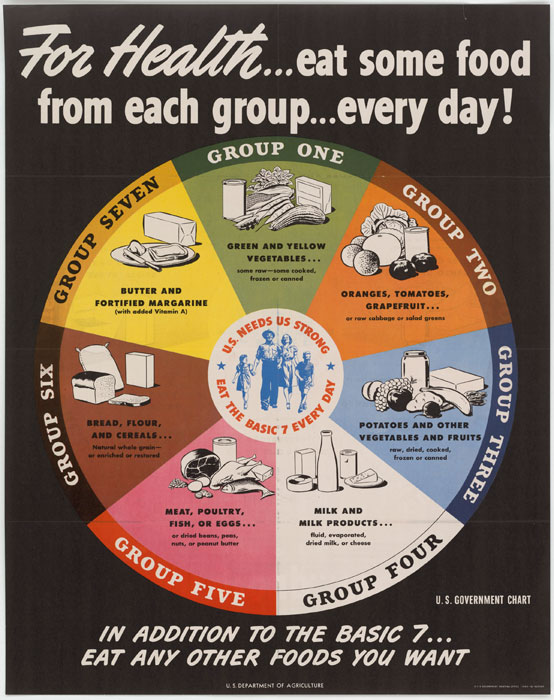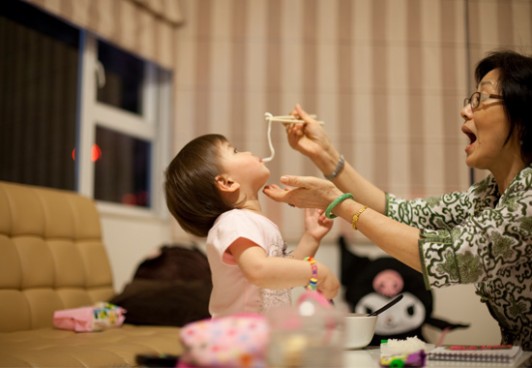Last month, I got an email from reader Robyn:
My son is an amazing, precocious, active kid who has a love for all things sweet. He has always been on the higher end of the weight range but at this year’s annual visit things were more alarming and I realized that it’s time to start reigning things in. I am trying to figure out how to have age-appropriate conversations with him about eating healthy. My husband and I have struggled with our weight all our lives and don’t want to pass that along, but it also makes me question my own ability to address the topic with my son appropriately. I’m hoping you may have advice.
This is a great question, one that I’m not in any position to answer expertly, so I thought I’d call upon my friend Dr. Joanna Steinglass, a clinical researcher at Columbia Center for Eating Disorders. CCED focuses their research on eating behavior across the spectrum, including anorexia nervosa, bulimia nervosa, binge eating, pediatric and adult obesity and Joanna was nice enough to join us today to address Robyn’s question as well as a few others.
DALS: Welcome Joanna! Let’s start with some elementals. Say you have a new baby — a complete blank slate. What’s the ideal way to talk about food with this child from the start? What is the blueprint for fostering a healthy relationship with food and body image?
JS: First, there is no one “ideal” and no specific blueprint, so take a deep breath and relax. There are lots of ways to raise a healthy kid. It’s also important to remember that your baby is not really a blank slate and will bring his or her own temperament and personality, which will be a factor in how you go about nurturing a healthy relationship with food and body. Having said that, there are some core concepts that may be helpful. You can tell them “People come in all shapes and sizes. No one shape or size is better than another.” There is a nice children’s book called, Shapesville by Andy Mills and Becky Osborn that illustrates this point for kids in the 2 to 5 range. It’s also important that parents set an example for kids in the way they treat other people. If your kids learn that you don’t judge others based on their size, they’ll be more likely to internalize that. It’s worth making this point out loud whenever the opportunity arises by saying things like, “People can be healthy at any size” or “I like people in lots of different shapes and sizes.”
DALS: What if you have a kid who has gotten into some bad eating habits and you want to re-route him. How do you talk to him or her about this without making him/her feel bad about himself/herself?
JS: Focus on health not weight. And emphasize function over form. Remind your son that a healthy body is what allows you to do all that you do in the world. Think of something your child likes to do – whether that is a sport or otherwise – and point out how it’s his body that does that. If your child is an athlete, he or she probably gets a lot of reinforcement for this idea. But even if what your child most likes to do is to sit quietly and read or draw, you can reinforce the concept. You can say, “Your body is what allows you to do [fill in your child’s favorite activity]” to foster your child feeling good about his body’s capability.
And remember, when it comes to making dietary changes, think about your family as a whole. If there are small changes that will benefit everyone — like switching from 2% to 1% milk, or increasing the use of olive oil and decreasing the amount of butter — then there is no need to point out or label one person’s behavior.
DALS: I know a mom who was very worried about her son’s weight and couldn’t stop herself from nagging him at the dinner table. She knows this isn’t good — “It feels awful” — but she can’t help it. Can you a) confirm that this is a counterproductive strategy and b) tell my dinner-loving readers what we should be doing/not doing at the dinner table?
JS: I think anyone who has ever had a parent knows that this has potential to backfire! Here are things to think about before you sit at the table:
- Always focus on the behavior, not the person. This cannot be emphasized enough. Avoid teasing. For example, even when you mean well, chides about weight can hurt much more than you realize. Parents sometimes try to make a joke to make light of the issue, but end up humiliating the child. Talk to your child away from the dinner table (we call this, “when the iron is cold”) about things they can do differently at the mealtime (e.g. smaller portion sizes, eating vegetables first, drinking water instead of juice) to increase healthy eating behaviors.
- No food is either “good” or “bad.” It is more useful to talk about foods as “sometimes foods.” Similarly, food is neither “healthy” nor “unhealthy.” But the phrase “Sometimes foods” is key.
- Increase the availability of healthy food choices at each meal. Eating behavior doesn’t change on a dime. Just keep putting more whole grains and leafy greens on the table. Make no assumptions about what kids will or won’t like. Offer much praise to anyone who tries it – just takes a taste. Kids’ tastes keep changing over time and if the food is there for them, you increase the odds.
- For some kids, it is useful to provide structured meal and snack times and encourage snacking in the kitchen or dining room, rather than other rooms of the house. This increases mindfulness around eating, and decreases eating in front of the TV which is a common source of extra intake.
- Positively reinforce a child’s healthy choices – this can be just in the form of noticing it and praising. “Good job trying something new!”
DALS: What are some more tangible steps parents can take to help their kids improve their eating habits?
JS: If you need to make some changes, it’s a good idea to keep a careful record of what is actually being eaten. This can help you target areas where changes will be easiest. If your child is young and you are the one providing the food, you can spend a week writing down everything your child eats (hopefully without them noticing that you are doing this). You may find that there are some simple, small changes you can fit in – if your kids are snacking in front of the TV, make sure they are snacking on vegetables. If you discover that they are actually ending up with desserts at lunch and dinner, cut back to one a day. It’s also helpful to remember not to focus so much on what your child ate in a single day; looking at what the child ate over the course of a week is a more helpful exercise, especially with young kids. If your child is older, you may want to sit down together and figure out ways to make small changes. You may need to find out what your child is actually eating outside of the house.
DALS: My daughter’s friends all play soccer, basketball, lacrosse, or take dance, but she’s just not the sporty type. How can I convince her that this is a crucial part of being healthy?
JS: There are lots of ways to be healthy and team sports may not be for everyone. Be broad in your own definition of what healthy is. Be creative. Being healthy is ultimately about lifestyle, not just sports. That means taking the stairs instead of the elevator; biking or walking into town or a friend’s house for a playdate; doing a scavenger hunt in your neighborhood; playing hopscotch or catch in the driveway. Lead by example – build family activities into your life. Go for walks together. Use what you already know about your kids to develop motivators. Little kids can be given jobs – to hold the map, to be the line leader. Bigger kids might be rewarded for finding interesting things, or given control over where to go. Aim for active vacations, with activities that will appeal to all members of the family. Also be mindful that children who are not ready for team sports at one age may develop an interest later.
DALS: How connected are stress and eating with kids? Do they eat more when they have a tough day at school? Or are there other triggers that we should be looking out for?
JS: For this question, I looped in my colleague at the Columbia Center for Eating Disorders, Deborah Glasofer, PhD, who has done work on obesity prevention in youngsters. Here’s what she says:
DG: Kids, like adults, do eat in response to emotions – both positive and negative emotions. In fact, lots of children and adolescents report emotional eating, with higher estimates in adolescents, overweight kids, and in those who report other forms of disinhibited eating (e.g., feeling a loss of control while eating). Emotional eating has been linked with the onset of binge eating episodes and can at times be associated with changes in mood.
If you notice a pattern of emotional eating in your child, begin a dialogue about stressors that might trigger and feelings that might underlie the eating behavior. Ask about what’s going on in their classes or outside activities, with their friends, or at home with their siblings. Helping your child develop an ability to talk, rather than eat, their way through emotions will help them to create a healthier relationship with food. Modeling healthy coping strategies (e.g., exercise to combat stress or low mood, non-food rewards for exciting accomplishments) for high emotion moments will also help.
DALS: Do you know of books, websites or tools that are doing a good job of teaching this stuff? We’d love to hear some recommendations.
DG: Check out chapters on overeating and obesity, picky eating, and body image in The Parents’ Guide to Psychological First Aid: Helping Children and Adolescents Cope with Predictable Life Crises, edited by Gerald P. Koocher and Annette M. La Greca. It covers a wide range of parenting topics in an accessible style and directs readers to other potentially helpful resources.
DALS: Thanks Robyn, Deborah, and Joanna! If readers have any questions for Joanna, please ask them in comment field below and she’ll do her best to address them.






This was so helpful. Thank you JoAnna and thank you Jenny for taking on a subject that can be really stressful. I will definitely put this advice to good use.
The younger the child, the easier it is to just limit the available options to healthy choices. If it’s not in the house, then there’s no argument about eating it. Of course, this means that everyone has to participate in the same restrictions, which can be helpful in terms of modelling the healthy behaviour.
One of the “dinner time rules” that we emphasize is stopping eating when you’re full. Letting children serve themselves and making sure they know it’s ok to not clear their plate can help them pay attention to their body’s natural cues not to overeat.
I think learning to cook healthy meals can be great for older children as they will get satisfaction from learning new skills and pride in accomplishment. It provides a way to still feel excited about the food without it having to be a “treat” item. They will also be more likely to want to eat something new if they helped make it.
I was given “Elliott’s Extraordinary Cookbook” when I was about 10 and I think it’s a fantastic introduction for children ready to be more independent in the kitchen.
I have a 10 year old girl who is very thin but not very active. As she ages I am hyper aware of talking to her about making healthy choices, not just at the dinner table but in her life. Now with her three year old brother coming up who is very active but all he wants to eat is sugar this was helpful to think of new ways to talk with both of them about how to treat their bodies. I try not to harp too much, I’m always worried I’m going to give my daughter an eating disorder and my son is going to be a fatty (neither are, I just worry). Thank you for posting this.
At my childrens’ school they introduced the concept of “go foods, slow foods and Whoa! foods.” They brought it home to us and I now use this all the time. They get it and it helps them to be reasonable about the conversation.
My children were always at the top of the height weight charts and by making two simple changes we were able to impact that. #1 – at home we only drink water and at restaurants we usually pick between a sugary drink and a dessert. #2 – when they are hungy we always put out a whole fruit or vegetable (ie – fruit before breakfast; raw carrots or cucumbers or something similar before lunch or dinner – when they are REALLY hungry they eat it without complaint and with enthusiasm).
Not hard and has really helped!
oops – forgot to include the web site on the go, slow and whoa!
http://kidshealth.org/kid/stay_healthy/food/go_slow_whoa.html#
I’m a big believer in just keeping stuff out of the house. For example, I never buy soda to bring home, and the only juice I buy on a regular basis is OJ. Everything else is a once-in-awhile thing (when we go out to eat, I let the kids order whatever drinks and food they want). I also do not serve dessert every night, and they very rarely ask for it. I think not having it in the house is the first half of the “battle.” Also, kids will eat what they are used to. Other moms wonder why my kid likes lox or fish or blueberries or string beans, and I tell them because that’s what they’ve always eaten. Also, I chalk up a lot of my kids’ food adventureness to Baby-Led Weaning. They (3 and 4.5) can still be a little picky (one doesn’t like peanut butter, the other doesn’t like meat that much) but overall, they have pretty wide palates because they’ve been exposed to everything. We also have a no media devices rule at the dinner table (adults and kids alike).
Thank you for this article! My 18-month-old used to eat everything…now it’s a daily battle to get a single healthy thing in his mouth. I’ve struggled with weight my whole life and I want our family to have healthy habits that, like many commenters have pointed out, are just ingrained in our family from the go. This article really reinforced that leading by example (being healthy and active at a time when the kids are forced to go along with me) is the best way to get that going.
PS- I love the book so very much. With two under two, I’ve turned to it for marriage and parenting advice as much as for cooking info. Is there any way to get DALS bumper stickers at this point in the game? My kitchen is sorely missing one. <3
This was really helpful. Can you offer any suggestions about how to navigate one child who doesnt eat and another who can’t regulate (and we are concerned about weight)? Its tough to manage both.
Every parent, child and situation is so different. This can be a very frustrating topic. I have the slender teen boy that is addicted to technology. He’s not interested in sports. Even with screen limitations he’s not very active. The favored alternative is reading. At least he mostly makes healthy food choices.
Thank you for bringing up such an important topic. There is a lot of great advice in here. I would add yoga! It can be transformative for children, especially those who may not feel very athletic. It builds self esteem, improves body image, helps digestion, and has so many other benefits. Getting children into yoga a young age is a great way to inspire better health choices, especially around food later on.
Robin, my 15 year old son is similar to yours. Never has liked sports, loves video games, computer, sedentary activities like reading, etc. Very slender and eats well, rarely eats snacks, not too interested in sweets. I would never push on any of my children an activity that they don’t want to do (i.e. sports), but of course exercise is an important component in their lives. So, one of his chores is to walk the dog twice around the block. Then, when I get home from work we all take another walk. I try to emphasize that we are walking for the health of our hearts versus putting any emphasis on weight, burning calories, etc.
And at meals I do try to teach my kids to stop eating when they are full. I think that this is crucial – to learn how to eat intuitively. I grew up having to clean my plate, which is never a good thing. It took me years to figure out if I was full or not.
I think that modeling good/healthy eating habits is more effective than talking about nutrition, which can seem prescriptive and joyless. But by all means talk about the deliciousness of the food on the table, about ingredients, provenance, about cooking, and looking forward to seasonal treats!
Don’t bestow ‘forbidden fruit’ status on any food or ingredients, just set a few easy to observe rules such as sitting down to eat as a family, and at least trying everything on the plate (mine had to clear their plates, never did them any harm!)
Learning about good food and etiquette is an important part of children’s education and socialisation, which is why I am a passionate believer in schools providing a tasty, healthy meal for kids whose parents/carers, for whatever reason, can’t provide one in the home.
The timing of this piece couldn’t have been better. My daughter just turned 4 and I’ve been thinking a lot how to talk to her about why we don’t eat certain foods…or why we need to eat them in moderation. She is a great eater, we don’t keep “junk foods” in the house, she happily grabs raw veggies for snacks, and we only drink milk and water but as she’s starting school I’m finding her more interested in the processed stuff she sees her friends eating. Up until now, we just didn’t have it in the house and that was enough. So I guess what I’m looking for is a way to talk to her about food that doesn’t demean what her friends are doing or deny that some of it tastes good. I’m definitely going to check out that Go Food, Slow Food info – thanks Karen!
whoooaaa – diet soda is a “go food”? Not in my house.
I shared this on our Yumbox Facebook page. Thank you for all the great suggestions. Bringing awareness and tips on how to reduce childhood obesity is so important in our society. We also hope that our product’s design, through its focus on portion control and an illustrated food group guide will simplify the process of making nutritional education fun for kids – and not a chore for parents.
@Heather I agree–too many of those “go” foods are highly processed. Teaching kids egg whites are preferable to whole eggs? Weird. Also, low-fat dairy is not only highly processed but not recommended for younger kids.
I notice some commenters here are still using the language of weight and size instead of focusing on habits, which Dr. Steinglass specifically recommended against.
I want to add that there is no scientific research to demonstrate that talking to kids about nutrition improves their eating.
I am a big believer in Ellyn Satter’s division of responsibility in eating. Parents decide what and when to eat, kids decide whether and how much. Parents stay on their side of the line and don’t interfere with kids’ natural cues and ability to self-regulate.
Also, she advocates regular access to “forbidden foods.” Learning how to deal with sweets is part of life and kids that see them as infrequent and forbidden are MUCH more likely to binge on them when they have the chance. Trust me, I was that kid.
For Alisa, who asked how to manage when your two kids seem to need different strategies .
-This is indeed challenging. It reminds of all the sleep books that seem to be missing the chapter on how you sleep train the SECOND child, when the two share a room. The first thing is to acknowledge that Yes, that is challenging, and NO, you are not missing some obvious solution.
– One possibility is to focus on healthy eating habits that will benefit the whole family. Provide energy dense foods that are healthy (olive oil, avocado, nuts). Set portion sizes that are appropriate for everyone.
– Another option is to recognize that kids are different, and this will not be the only issue where their needs differ.
Hope that is helpful.
What a wonderful, helpful topic!
Any suggestions for steering an 8-year old newly declared but very strict vegetarian? We tend to eat lots of pasta and simple veggies during the week but I’m sure we need to focus more on combing foods to get the right balance. Books? Nutritionist? Thanks.
I would absolutely second Ellen satyr’s books. She has made a massive impact in my sanity as well as my kids’ eating choices. No matter what your child(ren)’s issue(s), and even if they are different, satyr’s ideas work. I don’t agree with all her nutritional guidance, but that’s a different topic. She will help with all the emotional and control issues that happen around the table. “Child of mine” is the book of hers I read.